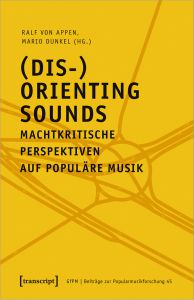(Dis-)Orienting Sounds. Machtkritische Perspektiven auf populäre Musik. Collected volume of the 28th Working Conference of the German Society for Popular Music Studies (GfPM). Ralf von Appen and Mario Dunkel, editors
If conscious and unconscious orientations are fundamental to human experience, then sounds can “simultaneously drive and be the object of orientive and disorientive processes” (7). Taking their inspiration from Sarah Ahmed’s Queer Phenomenology (2006), the editors of the conference volume (Dis-)Orienting Sounds sought to highlight and query just how popular music can serve as a medium for a varied range of orientations in a way that is critical of power and control.

Their Objective is largely met in this volume’s thirteen essays, which are grouped according to the music education-related, intersectional, and research-specific perspectives from which they are written. This volume offers stimulating insights and considerations pertaining to a broad spectrum of orientations based on identity (from gender identity to ethnicity to post-humanity and much more) while also enabling recognition of three new and/or additional general orientations, in part mutually contingent, that may become central to the field of popular music studies in the future.
This has firstly to do with the clearly discernible call for more self-reflectiveness with regard to both pedagogical concepts and structures as well as to the researcher-as-subject. Second of all, several of the contributions make it clear that multidimensionality has long since ceased to be a mere buzzword in popular music studies, with a combination of differing methods, perspectives, and objects now appearing to go without saying. And thirdly, one can sense a demonstrative openness here with regard to ways forward that have been but lightly travelled thus far—such as biographic case reconstructions, circularly conceived group interpretations, and above all an increasing orientation towards praxeological research. Sociocultural practices of the present and the past, whether in the context of online comment forums or with an eye to media technologies and concert locations, are placed in relation to music and thus expanded by meaning-oriented, text-centred approaches.
Particularly noteworthy in terms of their content, to my mind, are the contributions by Petter Dyndahl, Katharina Alexi, and Peter Klose: Dyndahl takes the Norwegian system of music education as an example that makes visible things including how elevating popular music to the status of “legitimate culture” (24) can entail processes of cultural gentrification; Alexi mercilessly exposes the ironic “secondary and neo-sexism” (119) as well as “neo-gentlemen’s jokes” (128) in German indie, punk, and rap; and Peter Klose’s analyses of live music events in terms of situative change shows how an alternative historiography that looks at bodily and material aspects of popular music might shape up.

